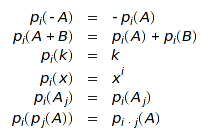muEC::SFA::SfAExpand – expands a SFA expression
expands a SFA expression
Call:
muEC::SFA::SfAExpand(sfa)
Parameters:
|
sfa: |
any valid expression in vlist |
Related Functions:
muEC::SFA::SfACollect, muEC::SFA::SfAVars, muEC::SYMF::SfEval, muEC::SYMF::SfPlethysm
Details:
The muEC::SFA::SfAExpand function expands, whenever possible, any expression in SFA. It is a direct implementation of the ![]() -ring structure, i.e. symmetric functions are considered as operators over the ring of polynomials.
-ring structure, i.e. symmetric functions are considered as operators over the ring of polynomials.
Expansion is inductively propagated, thus enabling chains of plethysms.
Alphabets are either formal alphabets (![]() ,
, ![]() , ...), or real constants (any float object or any formal variable which in not one of the
, ...), or real constants (any float object or any formal variable which in not one of the ![]() , or variables (when explicitely so declared), or symmetric functions of SFA, or any linear combination of alphabets. For instance, 3/2*A1 + k*(A2 - s[3](-A1)) is a valid alphabet.
, or variables (when explicitely so declared), or symmetric functions of SFA, or any linear combination of alphabets. For instance, 3/2*A1 + k*(A2 - s[3](-A1)) is a valid alphabet.
One may declare variables by setting e.g. SfAVars({{x}, {y}, z1, z2}). Here, z1, z2, all xi's, and all yi's will be held as variables within alphabets.
Rules used for e.g. power sums symmetric functions are:

where ![]() is a real constant different of then
is a real constant different of then ![]() ,
, ![]() is an explicitely declared variable,
is an explicitely declared variable, ![]() is a formal alphabet and
is a formal alphabet and ![]() and
and ![]() are positive integers. Equivalent rules for the other bases are also implemented.
are positive integers. Equivalent rules for the other bases are also implemented.
muEC::SFA::SfAExpand( p[4,2](7+A1) );
![]()
muEC::SFA::SfAExpand( s[2](A1 - 3/2*A2 + k) );
![]()
muEC::SFA::SfAVars( { {x}, {y}, z1 } );
![]()
muEC::SFA::SfAExpand( p[3]( q*m[2,1]( x1-k+A2 ) - z1^2+C ) );
![]()